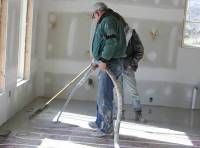- 87 reads

Spend $3,000 now and
SAVE $200 each year...
ROI = 13.3%
Highlights
For a thermal advantage, use stone or ceramic tile on top of a masonry base layer that goes over the plywood sub-floor. Tile hold temperatures much better than wood, but due to the additional weight, for large rooms, you may need to increase joist sizes and/or put them at 12" vs. 16" on center. For the masonry layer, the additional cost of Gyp Crete vs. Concrete is worth the investment due to the easier maintenance especially if radiant coils are embedded in the base. Expect to pay about $3 / foot for Gyp Crete at a depth of 1 1/4". In certain installations you may want to consider insulating the underside of the ceiling below the primary space, if the lower level, like a basement or crawl space, is not used as frequently.
The thermal gain is significant since masonry materials holds the heat and the cool for up to six hours and re-releases it back into the room, thus reducing the demand on your A/C or Furnace during that percentage of the day. This works great in conjunction with radiant floors and/or rooms that have southern exposure and overhangs that shade in the summer and let heat in over the winter to warm the thermal mass. Similar benefits can come with thermal mass walls or even water tanks positioned strategically in the home.
The ROI Calculation is based on 1,000 square feet of floors with utility bill savings in both summer and winter.
 Half inch thick stone or ceramic tile adds to the thermal mass of the 1 ½ Gyp Crete that in this case is poured over the radiant floor tubing.
Half inch thick stone or ceramic tile adds to the thermal mass of the 1 ½ Gyp Crete that in this case is poured over the radiant floor tubing.
TAKE ACTION
For a Directory by State of 'Green' Builders, Utility/Sponsors, and Lenders: Click Here

To avoid any future cracking from the expansion and contraction due to seasonal temperature change, use a fracture guard membrane between the slab and the tile.

The fracture guard easily rolls on and typically dries with a day before the tile goes down.


